Movie Crazy (1932)
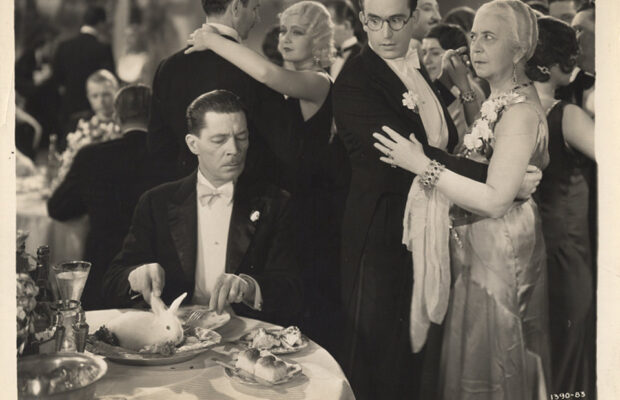
Toronto Film Society presented Movie Crazy (1932) on Monday, July 11, 1983 in a double bill with Sunset Boulevard as part of the Season 36 Summer Series, Programme 6.
Production Company: Paramount. Director: Clyde Bruckman. Story: Agnes Christine Johnson, John Grey and Felix Adler. Released by: Paramount Publix at the Rialto Theatre.
Cast: Harold Lloyd (Harold Hall), Constance Cummings (The Girl), Kenneth Thomson (The Gentleman Heavy), Sidney Jarvis (The Director), Eddie Fetherstone (An Assistant Director), Robert McWade (The Producer), Louise Closser Hale (The Producer’s Wife).
Though in his heyday as popular as Chaplin and more so than Keaton–in 1925 The Freshman drew crowds as large as The Gold Rush–Harold Lloyd (1893-1971) is now the most underrated of the three great silent comedians. (A fourth is customarily added–Harry Langdon–but in number of films, length of career, universality, and just plain interest he is surely infinitudes below the other three, a notch or two above the Johnny Hineses).
The reason often advanced for the current low esteem in which Lloyd is held, by critic and audience alike, is that his comedy has nothing to say about the human spirit: Chaplin’s battles with the established society, so often embodied in the huge and obese Eric Campbell, and Keaton’s battles with embodiments of the machine age in particular, touch more universal springs. Moreover, Lloyd’s is not the comedy of laughter and tears, but only laughter. “If great comedy must involve something beyond laughter,” James Agee has written, “Lloyd was not a great comedian.” Finally, Lloyd’s private life, unlike those of his two great contemporaries, and indeed unlike that of the typical clown, was relatively untroubled and even happy.
It is possible, however, to see another more striking reason for Lloyd’s decline. By the mid-1920s, the middle classes, who had shunned them before, began to take up the movies. More than Keaton, and much more than Chaplin, Lloyd is a middle-class hero: he does not constantly guy the social ritual, a Chaplin does; nor does he exist largely outside society, as both Chaplin and Keaton do. He is constantly trying to be part of the middle class, trying to be a regular feller, as his dress alone would suggest. No baggy pants (unless that happens to be the fashion in college that year), no threadbare jackets, Lloyd dresses like an ordinary American of the Jazz Age. In Keaton’s College, Buster, in spite of himself, becomes an athletics star in order to win the heroine. For Lloyd in The Freshman the winning of the heroine is secondary, the attainment of campus fame and popularity primary.
Thus when the silent comedians returned to general currency in the 1960s, a period when social conformity was not wholly the prevailing mode, and the middle class not altogether the toast of those who mould public opinion, Lloyd fell further away from his place near to Chaplin and Keaton. Chaplin’s concern for the little man had never waned in popularity, but his long attachment to left-wing causes could only add to that popularity in the ’60s, when Keaton’s assertion of individuality also held a much greater appeal than Lloyd’s allegiance to the social group.
Movie Crazy, which is Lloyd’s third talking picture, and his most successful in the essentially alien medium of sound, conforms to the pattern. Indeed, it is modelled very closely upon his greatest success, The Freshman: Lloyd’s two most famous sequences (outside of the vertiginous antics on the clock in Safety Last that everybody remembers) are the one in The Freshman in which Harold’s dinner jacket, tatted together at the last minutes, comes gradually apart at the Prom as the tailor waits behind curtains and underneath tables to perform vain repairs upon it, and the reprise of this sequence in Movie Crazy, as Harold mistakenly puts on a magician’s jacket, which at a Hollywood party proceeds to give off playing cards, white rabbits, a squirting boutonnière, and all the paraphernalia of professional magic.
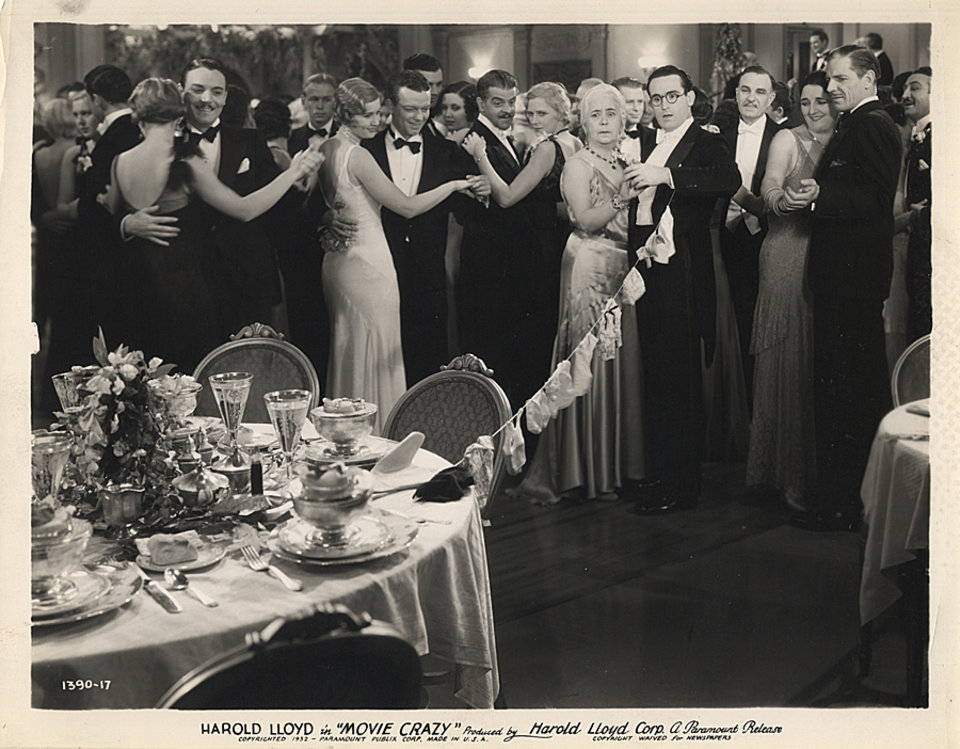
But the plots of the two films are parallel as well. The Freshman finds Harold going off to college with the aim of becoming a campus hero; Movie Crazy finds him going off to Hollywood to become a great star. Each film begins with a cinematic witticism: Harold as the great cheerleader is revealed, as the iris opens out, to be practising in front of his mirror; Harold riding in a luxurious automobile is revealed, as the car speeds away, to be riding in a bicycle hitherto hidden from view. Early in each film is Harold’s arrival at the railroad station, surrounded by accidents caused by his ineptitudes. Eager to please in both situations, he twice upends the Dean in the one case; in the other he is at once enlisted as a film extra, spoiling every shot with his impromptus. In both films, of course, Harold’s efforts are crowned at the end with the success he sought from the beginning: secondarily the girl, primarily the status of gridiron hero and Hollywood star.
Comedy, much more than tragedy, is of the social group. Laugh and the world laughs with you, etc. Comedy repudiates what it cannot accept as belonging to the group. And this is the mainspring of Lloyd’s art: middle class audiences laughed uproariously at him, and perhaps still do; those less willing to accept society as it is prefer the loser to the accommodating winner, especially if he loses to social forces–Chaplin, Sellers, Woody Allen–but derive their greatest satisfaction from seeing the loser prevail against society, or make it conform to him (The Gold Rush, Being There, Annie Hall). No one would wish the ending of City Lights to be any different, but the endings of The Freshman and Movie Crazy ratify certain distinctively American qualities of perseverance, diligence, sheer idealism and optimism. Is the loss of esteem for such qualities another reason for Lloyd’s decline?
The director of Movie Crazy is Clyde Bruckman (1894-1955), who had a long and distinguished record in silent and early sound comedy. He scripted several of Keaton’s comedies, including Sherlock Jr. and The Navigator, and co-wrote and co-directed The General. He also scripted Lloyd’s For Heaven’s Sake (1926) and Professor Beware (1938), and directed Lloyd’s second sound film, Feet First, as well as one of Laurel and Hardy’s most famous shorts, Putting Pants on Philip, and one of W.C. Field’s, The Fatal Glass of Beer. He did have the sad life which Lloyd seems to have lacked, later took to drink, and shot himself in a restaurant after a meal for which he could not pay.
Lloyd had many leading ladies, appearing most often with Mildred Davis (Safety Last), whom he married and to whom he remained married, and Jobyna Ralston (The Freshman). Movie Crazy was the only film in which he was supported by Constance Cummings (b. 1910), an American actress who made a number of films in the United States in the 1930s before settling in England. She is perhaps best remembered as Ruth, the second wife, in David Lean’s version of Coward’s Blithe Spirit (1945).
But the dominant figure of the film is, as always, Harold, the name he always bears, whatever the surname and whatever the character. The horn-rimmed glasses and the brushed-back hair are not as well remembered as the bowler, cane and baggy pants, or the great stone face. But they are no less a part of the great American comic tradition.
Notes by Barrie Hayne

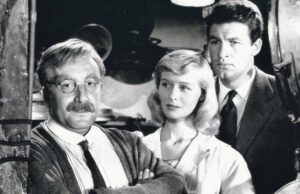
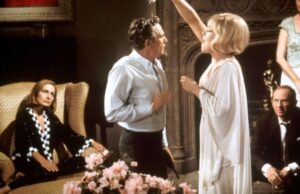
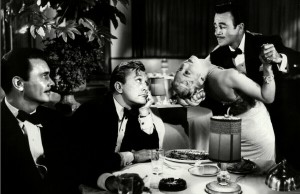






Leave a Reply